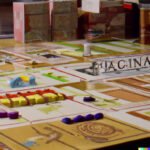Classic childhood board games bring back fond memories of family gatherings, laughter, and friendly competition. From traditional favorites like Monopoly and Scrabble to lesser-known gems like Candy Land and Chutes and Ladders, these games have been a staple in many households for generations. In this article, we will explore the nostalgia and importance of classic childhood board games, their evolution over time, educational value, social benefits, and tips for passing on the tradition to the next generation.
As we reminisce about our childhood, classic board games often hold a special place in our hearts. They not only provided hours of entertainment but also taught us valuable lessons in strategic thinking, problem-solving, and sportsmanship.
Whether it was rolling the dice or moving game pieces around the board, these activities brought joy and excitement to our formative years. Today, as technology continues to dominate the playtime of children, it is crucial to highlight the enduring relevance of classic childhood board games.
In this section, we will delve into the history of classic childhood board games and their significance from ancient times to modern-day. We will explore how these timeless games have transcended generations and cultural boundaries. Moreover, we will discuss why these games continue to be cherished by both children and adults alike. Join us on a journey through the nostalgic world of classic childhood board games as we celebrate their enduring legacy.
History of Classic Childhood Board Games
The history of classic childhood board games is a fascinating journey that spans from ancient times to the present day. These timeless games have been enjoyed by people of all ages for centuries, providing entertainment, education, and social interaction. From ancient civilizations to modern innovations, classic childhood board games have evolved and adapted to changing times, yet their essence remains the same.
Throughout history, board games have been a significant part of various cultures around the world. In ancient Egypt, the game of Senet was played over 5,000 years ago and was believed to have religious significance. Similarly, the Royal Game of Ur was popular in Mesopotamia around 2600 BC and was considered a strategic pastime for nobility.
As time passed, classic childhood board games continued to evolve and spread across different continents. Chess originated in India in the 6th century and eventually made its way to Europe where it became a popular game of strategy and skill. The iconic game of Monopoly, which reflects the economic principles of capitalism, was first patented in 1935 during the Great Depression in the United States.
Classic childhood board games have transcended time and continue to be an integral part of today’s modern society. Whether it’s playing traditional games like Snakes and Ladders or exploring newer variations like Settlers of Catan, these beloved pastimes continue to bring joy and entertainment to people of all ages around the world.
The Top 10 Classic Childhood Board Games
When it comes to classic childhood board games, there are a few timeless favorites that come to mind. These games have been a staple in family game nights and playdates for generations, and their popularity shows no signs of waning. Here are the top 10 classic childhood board games that have stood the test of time:
1. Monopoly: This iconic game of buying, selling, and trading properties has been a favorite since it was first introduced in the 1930s.
2. Scrabble: A word game that challenges players to create words from letter tiles, Scrabble is not only fun but also helps improve vocabulary and spelling skills.
3. Candy Land: This colorful and simple game is perfect for young children, as they journey through a world of sweet treats to reach King Kandy’s castle.
4. Clue: A murder mystery game that requires players to use deductive reasoning to solve the crime, Clue has been keeping families entertained for decades.
5. Chutes and Ladders: A classic game of luck and strategy, Chutes and Ladders teaches young children important counting skills while they navigate the board’s ups and downs.
6. Sorry.: Players race to get all their pawns across the board while trying to send their opponents’ pawns back to the start in this exciting game of chance and strategy.
7. The Game of Life: This game simulates various life events from college to retirement, teaching players about the value of making wise financial choices along the way.
8. Connect Four: A simple yet addictive game of matching colored discs in a grid, Connect Four is perfect for kids and adults alike.
9. Battleship: This classic two-player guessing game requires strategy and keen observation as players try to sink each other’s hidden fleet of ships.
10. Operation: Players test their hand-eye coordination by trying to remove various ailments from a patient without setting off the buzzer in this beloved dexterity game.
Whether played on rainy days indoors or during family gatherings, these classic childhood board games continue to bring joy and entertainment to people of all ages. Their enduring appeal lies in their ability to foster friendly competition, encourage strategic thinking, and create lasting memories with loved ones.
How Classic Childhood Board Games Have Evolved Over Time
From ancient times to the modern day, classic childhood board games have evolved significantly. While some games have remained unchanged for centuries, others have adapted to cultural shifts, technological advances, and changing preferences of younger generations. One significant change in the evolution of these games is their transition from physical board games to digital versions available on various platforms.
In the past, classic childhood board games were primarily played using physical boards, dice, and game pieces. However, with the advent of technology, many of these games are now accessible as mobile apps or online versions. This shift has made these beloved games more convenient and accessible to a wider audience. Additionally, digital adaptations often include interactive features and updated graphics that enhance the overall gaming experience.
Despite their evolution into digital formats, many classic childhood board games continue to be popular in their original physical form. Traditional game manufacturers have also recognized the value of preserving these classics and continue to produce high-quality versions for those who prefer a more hands-on approach to gaming. This blending of old and new has enabled classic childhood board games to remain relevant and cherished by people of all ages.
In recent years, there has been a resurgence of interest in vintage versions of classic childhood board games. Collectors seek out original editions of these games as collectibles or for nostalgic reasons. The market for vintage board games has grown significantly, with some rare editions fetching high prices at auctions and among enthusiasts. This trend underscores the enduring appeal and significance of classic childhood board games in our ever-changing world.
| Evolution Aspect | Description |
|---|---|
| Digital Transition | Transition from physical boards to digital versions |
| Preservation of Classics | Continued production of traditional physical versions |
| Vintage Resurgence | Growth in interest and market for original editions |
The Educational Value of Classic Childhood Board Games
Enhancing Critical Thinking and Problem-Solving Skills
Classic childhood board games are not just a source of entertainment; they also serve as valuable educational tools. Many of these games require strategic thinking, critical reasoning, and problem-solving skills. For example, chess teaches players to think several moves ahead and anticipate their opponent’s strategy.
Similarly, Scrabble challenges players to form words using their vocabulary and spelling knowledge. By engaging in such games, children can develop essential cognitive skills that will benefit them academically and professionally in the future.
Improving Mathematical and Logical Abilities
Several classic childhood board games involve mathematical concepts and logical reasoning. Games like Monopoly involve money transactions, property management, and decision-making based on probability. This helps children to understand basic financial principles such as budgeting, investing, and risk assessment.
Furthermore, logical deduction games like Clue enhance children’s deductive reasoning skills as they try to solve a mystery by making logical deductions based on the clues provided. Overall, playing these board games can have a positive impact on a child’s mathematical and logical abilities.
Promoting Social Skills and Emotional Development
Aside from cognitive benefits, classic childhood board games also contribute to the social and emotional development of children. Games like Pictionary encourage communication and teamwork among players as they work together to guess the drawings. Additionally, cooperative games such as Candy Land teach children about sportsmanship, taking turns, following rules, and dealing with setbacks gracefully.
Moreover, these games provide opportunities for bonding with family members and friends, fostering empathy, compassion, and understanding of others’ emotions. As a result, classic childhood board games play an important role in shaping well-rounded individuals with strong social skills.
The Social Benefits of Playing Classic Childhood Board Games
Playing classic childhood board games offers more than just entertainment; it also provides numerous social benefits. Whether it’s spending quality time with family and friends or developing important social skills, these games have a lot to offer in terms of interpersonal interaction and communication.
Building Relationships
When playing classic childhood board games, people have the opportunity to bond with others over a shared experience. This could be a chance for family members to spend meaningful time together or for friends to strengthen their relationships. The friendly competition that often comes with these games can help create lasting memories and strengthen the connections between those involved.
Improving Communication Skills
Many classic childhood board games require players to communicate with each other in order to strategize or make decisions. Whether it’s discussing game tactics or simply engaging in friendly banter, these interactions can help individuals improve their verbal communication skills and learn how to effectively convey their thoughts and ideas.
Promoting Sportsmanship
One of the most valuable social benefits of playing classic childhood board games is the opportunity to learn how to win and lose gracefully. Games can teach valuable lessons about good sportsmanship, fairness, and how to handle both success and failure – all essential skills for healthy relationships and life in general.
Learning to navigate the emotions that come with competition is an important part of growing up, which is why classic childhood board games play a crucial role in teaching such lessons.
Tips for Introducing Classic Childhood Board Games to the Next Generation
As adults, many of us have fond memories of playing classic childhood board games with our friends and family. These games provided hours of entertainment and taught important life skills such as patience, strategy, and sportsmanship.
In today’s tech-savvy world, it can be challenging to tear kids away from their screens and introduce them to the joys of classic board games. However, there are several tips that parents and caregivers can follow to successfully introduce these timeless games to the next generation.
First and foremost, it’s important to choose the right game for the age group you are targeting. Young children may enjoy simple games like Candy Land or Chutes and Ladders, while older kids may appreciate more complex games like Monopoly or Risk. By selecting a game that is age-appropriate and aligns with their interests, kids are more likely to become engaged and enjoy the experience.
Another tip for introducing classic childhood board games to children is to set aside dedicated time for game nights. By making this a regular part of family routine, kids will come to anticipate and look forward to these special occasions. This also provides an opportunity for bonding and creating lasting memories with loved ones.
Lastly, parents should lead by example by demonstrating enthusiasm for playing classic childhood board games. Children often mimic their parents’ behavior, so showing genuine excitement for game nights can encourage kids to develop an interest in these timeless activities.
| Tips | Description |
|---|---|
| Choose Age-Appropriate Games | Select classic childhood board games suitable for the targeted age group. |
| Dedicated Game Nights | Set aside regular time for playing classic childhood board games as a family. |
| Lead by Example | Show genuine enthusiasm when introducing classic childhood board games to children. |
The Future of Classic Childhood Board Games
As we have delved into the rich history and enduring appeal of classic childhood board games, it is evident that these timeless pastimes hold a special place in our hearts. From ancient origins to their evolution in modern times, these games have continued to bring joy and entertainment to countless generations. Their educational and social benefits only add to their value, making them an essential part of childhood development.
While the landscape of entertainment may have changed with the advent of technology, it is crucial to recognize the importance of preserving the tradition of classic childhood board games. As we look to the future, it is essential to find ways to introduce these beloved games to the next generation. By sharing our fond memories and experiences with younger individuals, we can ensure that these games continue to be cherished for years to come.
In conclusion, classic childhood board games have left an indelible mark on our lives and continue to hold significance in today’s world. As we navigate the ever-changing trends in leisure activities, let us not forget the simple pleasures and valuable lessons that these games provide. By embracing and promoting their timeless appeal, we can work towards keeping the tradition alive for future generations to enjoy.
Frequently Asked Questions
What Are the Most Popular Classic Board Games?
The most popular classic board games include Monopoly, Scrabble, Chess, Checkers, and Risk. These games have been enjoyed by people of all ages for many years and continue to be widely played around the world.
What Is the Oldest and Most Popular Board Game?
The oldest and most popular board game is generally considered to be Chess. With origins dating back over 1500 years, Chess has stood the test of time and remains one of the most beloved and challenging board games in existence.
What Is the Oldest Board Game Known to Have Excited?
The oldest known board game is believed to be “Senet,” an ancient Egyptian game dating back to around 3100 BC. This game was a popular pastime in ancient Egypt and was often included in burials as a form of entertainment for the afterlife.

I love playing all kinds of games – from classics like Monopoly to modern favourites like Ticket to Ride.
I created this blog as a way to share my love of board games with others, and provide information on the latest releases and news in the industry.





